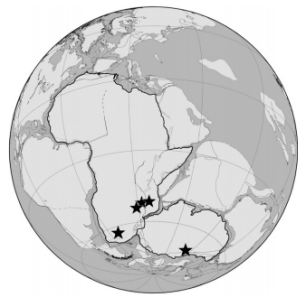The stars on this paleogeographic map of southern Pangea indicate the five areas were the most Permian and Triassic fossils are found.
The Daily Mail UK
written by Becky Evans
Tuesday April 30, 2013
Newly discovered fossils have given fresh insights into how the predecessors of dinosaurs developed 10million years after most of life was wiped out in Earth's largest ever extinction.
Seven expeditions to Tanzania, Zambia and Antarctica have uncovered some of the earliest fossils of pre-dinosaur creatures ever found.
They shed new light on how herbivore species - that eventually gave rise to dinosaurs - were able to compete after ancient species were decimated in a mass extinction 252million years ago.
Snapshots taken of life before and after catastrophic event show how the dispersal and destruction of so many species allowed others - including the ancestors of the first dinosaurs - to thrive.
Up to 96 per cent of all marine life and 70 per cent of land animals were killed in the mass extinction, known as The Great Dying.
It included the only known extinction of insects.
Palaeontologists from The University of Washington say the newly discovered fossils reveal a lineage of animals thought to have led to dinosaurs in Tanzania and Zambia.
Before the mass extinction creatures such as the pig-sized Dicynodon - a dominant plant-eating species - thrived across southern Pangaea- the name given to the landmass in which all the world's continents were once joined together.
Dicynodon disappeared after the extinction and newly emerging herbivores were able to compete.
Paleontologist Christian Sidor said: 'After the extinction animals weren't as uniformly and widely distributed as before. We had to go looking in some fairly unorthodox places.'
Another creature called an archosaur lived in Tanzania and Zambia but were not distributed across southern Pangaea, as had been the pattern for four-legged animals before the extinction.
Archosaurs, whose living relatives are birds and crocodilians, are of interest to scientists because it is thought that they led the first dinosaurs.
Animals like Asilisaurus, a dinosaur-like animal, and Nyasasaurus parringtoni, a dog-sized creature with a five-foot-long tail, which could be the earliest dinosaur, are believed to have evolved from them.
Professor Sidor said: 'Early archosaurs being found mainly in Tanzania is an example of how fragmented animal communities became after the extinction.'
As well as travel to southern Africa and Antarctica, researchers combed through existing fossil collections in museums.
Richard Lane, programme director in NSF's Division of Earth Sciences, said: 'These scientists have identified an outcome of mass extinctions - that species ecologically marginalized before the extinction may be "freed up" to experience evolutionary bursts then dominate after the extinction.'
The researchers created two 'snapshots' of four-legged animals on Earth about five million years before, and about 10 million years after the mass extinction event.
Analysis of the findings showed that before the extinction, 35 per cent of four-legged species were found in two or more of the five areas studied and some stretched for 1,600 miles.
Ten million years after the extinction, just seven per cent of species were found in two or more regions.
The research began in the early 2000s when expeditions were organised to sites in Tanzania that had not been visited since the 1960s and in Zambia where there had been little work since the 1980s.
Two expeditions to Antarctica provided additional finds, as did efforts to look at museum fossils that had not been fully documented or named.
The fossils turned out to hold a treasure trove of information, the scientists say, on life some 250 million years ago.
The paper of the findings that will be published in the journal Proceedings of the National Academy of Sciences.






































No comments:
Post a Comment